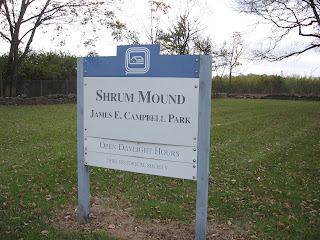Thousands of years ago, the Adena, Hopewell and Fort Ancient Indian tribes of Ohio built a number of different types of earthworks - conical mounds, platform mounds, and ridges or other shapes - that were used for burial or ceremonial reasons. A few of their sacred places remain in Ohio to this day.
Most mounds are named, often for the original family who owned the land the mound occupies. This one, along the Ohio River between Chilo and Neville in Clermont County, has two names.

I have always referred to this neglected mound as the Edgington Mound, because of this sign visible from Rt 52, which names it for the previous landowners.


However, when I stopped by to take some closer photos, I found this hidden plaque, naming the mound for Ruth Adomeit, a benefactress.

If Ruth's "generous donation" is being used to "make preservation possible," I think she needs to check the books. There is also a conflict on the age of this mound. the first sign indicates it is from the Adena culture (the earliest of the three periods) and this plaque says it represents the Fort Ancient period, the most recent.
Mounds are usually kept neat and are often marked with a simple sign courtesy of the Ohio Historical Society, as at Shrum Mound, in Columbus.
Shrum Mound has a well-worn path.
Mounds can have whole parks and memorials built around them.


Seip Mound, on Rt 50 in Ross County, has interpretive signs that explain the function of the mound and markers delineating the remains of the surrounding houses.

A trail leading to the mound tempts hill-walkers, but the signs request you stay off the earthworks.

Frequently, a modern day cemetery has been built around an ancient mound, connecting the ages. This unnamed mound is in a cemetery in Newton, between Cincinnati and Batavia.


In other places, mounds are in public areas. In Marietta, the Quadranaou, a large, rectangular, plateau-like mound is part of a community park.



No one complains if you walk on the Quadranaou Mound, but climbing Conus Mound (not pictured), also in Marietta and the centerpiece of the Mound Cemetery, will get you a $500 fine.


The earthen ridges that made up the walled path leading from Quadranaou to the Muskingum River were removed, but the boulevard that took its place is still referred to as Sacra Via, the Sacred Way.

Believe it or not, this rough hillock in the Prairie Oaks Metropark in western Franklin County is a long-lost Indian mound, unnamed, unloved, and uncared-for.


The grandmother of all Ohio mounds is this one, Serpent Mound, off the Brush Creek in Adams County.

Serpent Mound is "the largest and finest serpent effigy in the United States." Nearly one quarter of a mile long, it represents an uncoiling snake. It was originally excavated in the late nineteenth century.

A very old image of Serpent Mound shows the coiled tail at one end. The oval shape at the other has been assumed to mean many things - the serpent swallowing an egg, the earth or the sun, among other interpretations.

The head of the Serpent is aligned with the summer solstice sunset, and other parts point to the winter solstice and equinox sunrises. A powerful place of mystery and worship, climbing on the earthworks at Serpent Mound is most strictly forbidden.
The Serpent Mound is best appreciated from above. Being severely acrophobic, I was only able to make it to the first level of the observation tower.

But, the view was worth the terror, to see the Serpent undulating before me

Following the paved walking path, you can see the coils of the Serpent as it writhes its way across the land.

The Serpent's Head,









5 comments:
Katdoc, if you haven't already done so, I highly recommend the Cahokia mounds in Southern Illinois. Enormous and complex. Cahokia flourished as the metropolis of the Mississipian culture from about 1100 to 1500. I always appreciate it when archaic sites are named after the people who made them rather than those who later took them over ...
(After you've done moundclimbing you can go to St Louis and get a really good ice cream at Ted Drewes.)
LOG:
Mounds and ice cream - a perfect combo! I haven't been to Cahokia, but it sounds enticing.
I agree, it is nicer to name things after them as built 'em, not them what appropriated them.
~Kathi
How awesomely awesome! Never heard of these before.
I think the sketch of the serpent mound is actually a fallopian tube releasing an egg from the ovary. That's what I saw as soon as I looked at it (too many A&P classes lately, perhaps?)
Did someone say, "MOUNDS OF ICE CREAM?"
I love investigating mounds. I haven't been to Serpent Mound in forever. How's the birding there? Do we need a road trip?
: )
I'm with Holly--I too thought--oh, a sexual image.
Well, OK--probably serpents were associated with fertility in ancient culture.
Very interesting. I have read about the mounds, but nothing as extensive as your post.
Post a Comment